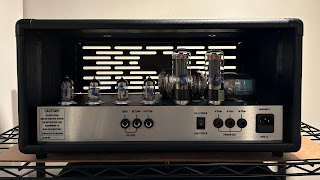 |
| Mesa Traditional 4x12. |
I grabbed a reference-quality 4x12 cabinet for $600 from Main Drag Music. The cabinet is a Mesa Boogie Straight Traditional 4x12. While the cab is not the mythical Standard Oversized cab, the Traditional size does have its fans. The Traditional 4x12 apparently is more mid-focused and not as scooped sounding as the Oversized 4x12.
 |
| Mesa 4x12 opened up. |
The cabinet is loaded with four 8 ohm 70W Mesa OEM Vintage 30s produced in May 2001. The early 2000s are considered to be a desirable period for the V30 as a result of the ubiquitous use on rock and metal albums. Mesa Boogie let me know that the cabinet was shipped in April 2002.
 |
| T4335 Vintage 30 with 18EL date code. |
These Mesa Vintage 30s do indeed sound less harsh than my other Vintage 30s. For the past few years, I’ve moved around my 2011 MIC Vintage 30 from cabinet to cabinet to get it to sound like every other clip online. I can stop trying to approximate that sound with this Mesa cabinet now. Whatever the recipe may be (UK manufacturing differences, 8 ohm impedance, cabinet construction), it sounds good. I also have four speakers to choose from for variety in a recording context.
 |
| Impedance Measurements Blue: Mesa Traditional 4x12 - V30 Teal: Suhr Reactive Load |
The cabinet sounds great with all of my high gain amps. The cabinet sounds balanced to me in the room. Listening to the speakers under a microphone confirms for me that there isn't a single sweet spot to a Vintage 30. Like with my other V30s, there are different zones to the speaker that sound best to my ears depending on the amp:
- Cap Center to Cap Edge: Mesa Rectifier Multi-Watt Vintage Mode, Crab Benzin VH3 Mode (Diezel VH4 sound), Mesa Badlander Crush Channel
- Cap Edge: Mesa Rectifier Multi-Watt Modern Mode, Mesa Badlander Crunch Channel
- Slightly Outside Cap Edge: Peavey 6505, Jet City JCA22H, Crab Marcus (Mesa Mark III sound)
Each V30 in this cabinet is slightly different in terms of frequency response. The most obvious difference seems to be in the 2-3k region, in which the two right speakers have more of. The lower left speaker seems to sound the most balanced for my tastes. I will share IRs of this cab to demonstrate the differences at some point.
I have recently gained a greater appreciation of the nuances between individual speakers within a cabinet. I have learned that there isn’t a monolithic sound for each speaker, rather subtle differences within a single model.
More to come.






























